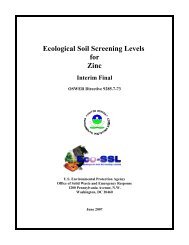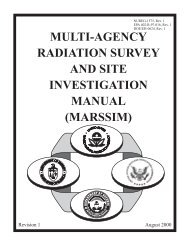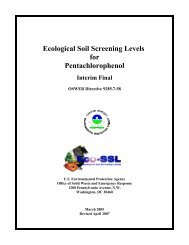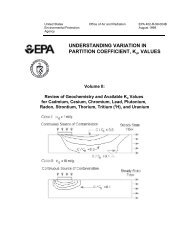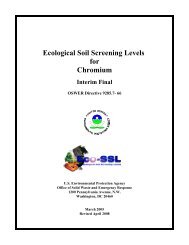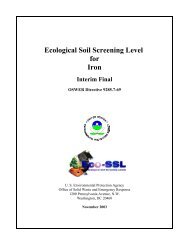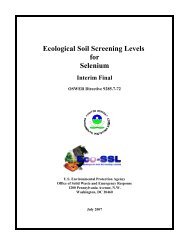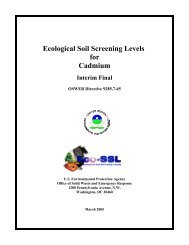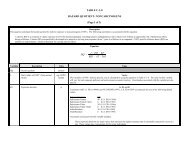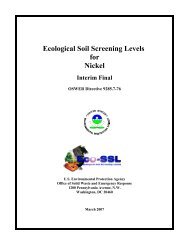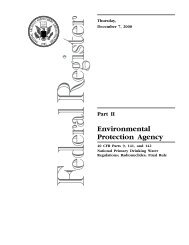Guidance for Conducting Risk Assessments and Related Risk ...
Guidance for Conducting Risk Assessments and Related Risk ...
Guidance for Conducting Risk Assessments and Related Risk ...
You also want an ePaper? Increase the reach of your titles
YUMPU automatically turns print PDFs into web optimized ePapers that Google loves.
7. RISK ASSESSMENT IN AND AFTER THE FEASIBILITY STUDY<br />
The feasibility study is a two-step process consisting of a preliminary screening of alternatives<br />
[(usually based on the identification of chemicals of potential concern (COPCs) <strong>and</strong> per<strong>for</strong>med prior to<br />
the final completion of the baseline human health risk assessment (BHHRA)] <strong>and</strong> a detailed analysis of<br />
those alternatives that pass the initial screening. Once the BHHRA is completed <strong>and</strong> a list of chemicals of<br />
concern is available, a more thorough screening of alternatives may be completed prior to the detailed<br />
analysis of alternatives to further reduce the number of alternatives evaluated in the feasibility study.<br />
The focus of the BHHRA is to evaluate the effect of selecting a “no-action” alternative on human<br />
health. The focus of the feasibility study is to evaluate both the short-term <strong>and</strong> long-term risks associated<br />
with the actual implementation of a remedial alternative (see Table 3). Short-term risks associated with a<br />
remedial alternative are those risks that occur during the implementation of the alternative (e.g., risks<br />
from emissions) <strong>and</strong> affect the persons who live <strong>and</strong> work near the site <strong>and</strong> the actual workers who are<br />
per<strong>for</strong>ming site remediation. Long-term risks are those risks that will remain after the remedy is complete<br />
(i.e., residual risk either from treatment residuals or untreated waste). In addition, the evaluation of longterm<br />
risks considers the effectiveness of the remedy over time.<br />
The methods <strong>for</strong> assessing both short-tem <strong>and</strong> long-term risks are the same as those <strong>for</strong> the BHHRA.<br />
The major differences are<br />
• the estimation of timing <strong>and</strong> duration of exposures,<br />
• the estimation of source terms (i.e., concentrations) to be evaluated at various times over the course of<br />
the remedy,<br />
• the need <strong>for</strong> short-term toxicity values (i.e., chronic values may need to be modified since the<br />
exposure duration will be less than a lifetime), <strong>and</strong><br />
• the consideration of worker risks including health <strong>and</strong> safety issues.<br />
<strong>Risk</strong> evaluations subsequent to the feasibility study are conducted on an “as needed” basis to ensure<br />
that the remedy is <strong>and</strong> continues to be protective. If new environmental data or other in<strong>for</strong>mation that<br />
would serve to refine previous analyses becomes available after the feasibility study is complete, this<br />
in<strong>for</strong>mation, <strong>and</strong> its effects on all proposed alternatives, is incorporated into the Proposed Remedial<br />
Action Plan.<br />
The Record of Decision includes a section on comparative analysis that discusses risk as it pertains<br />
to long-term effectiveness, short-term effectiveness, <strong>and</strong> overall protection of human health <strong>and</strong> the<br />
environment. This section also discusses how the remedy will eliminate, reduce, or control the risks<br />
identified in the baseline human health risk assessment; whether or not the remedy meets the established<br />
remedial goal options; <strong>and</strong> any risks resulting from residual materials.<br />
34



